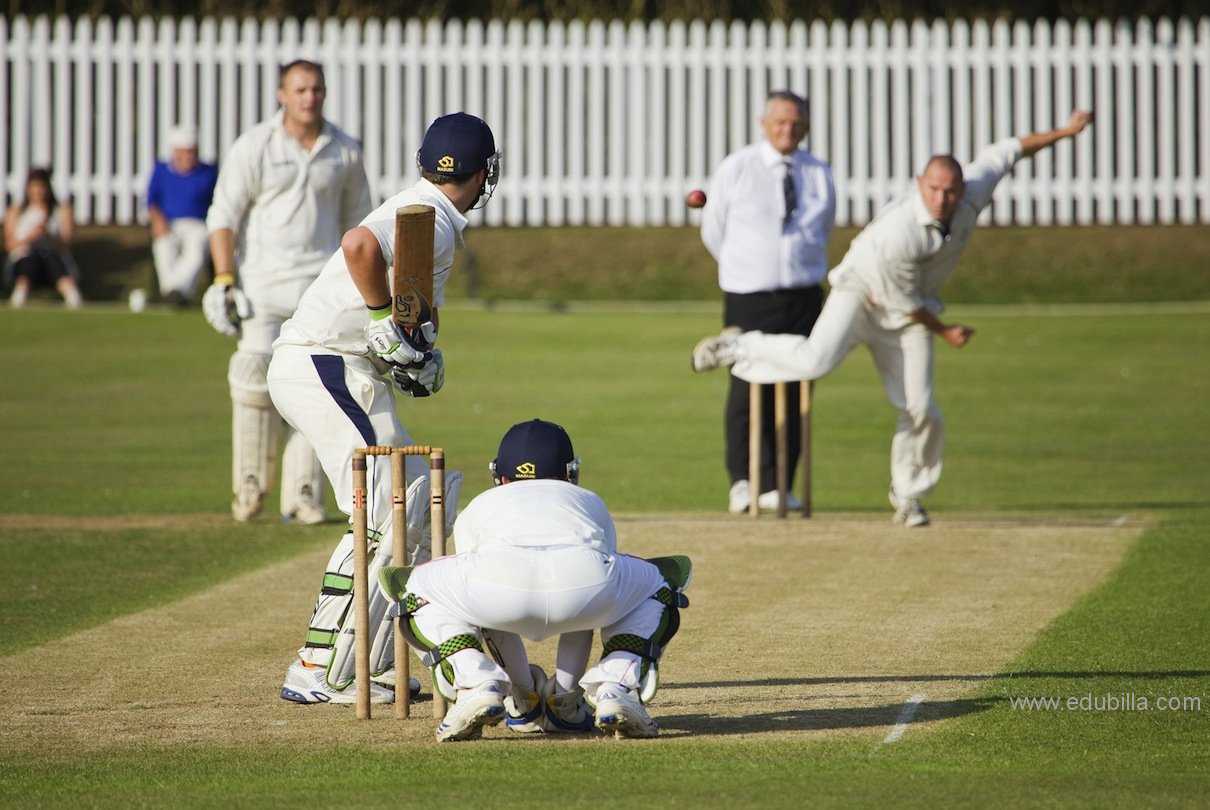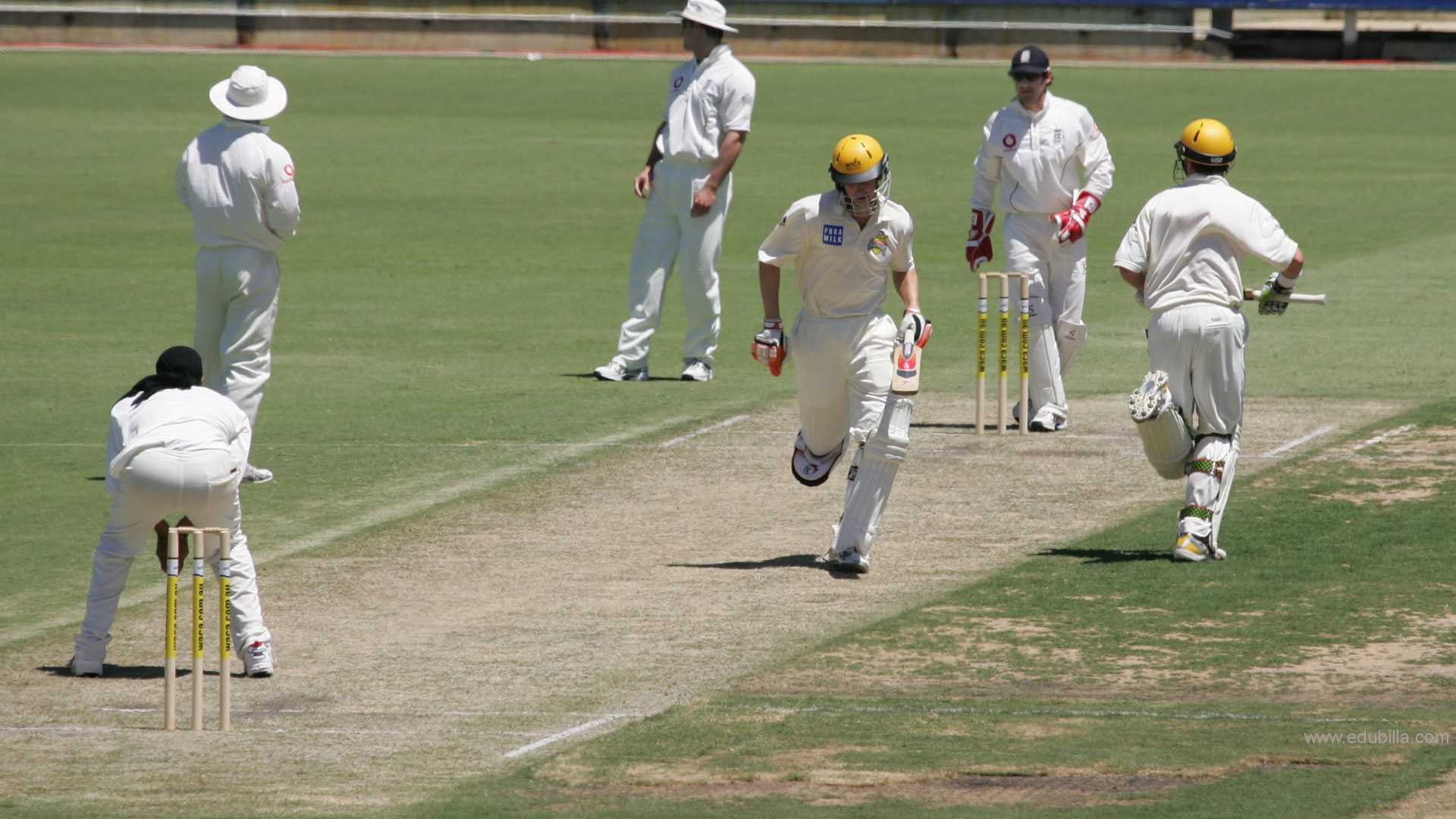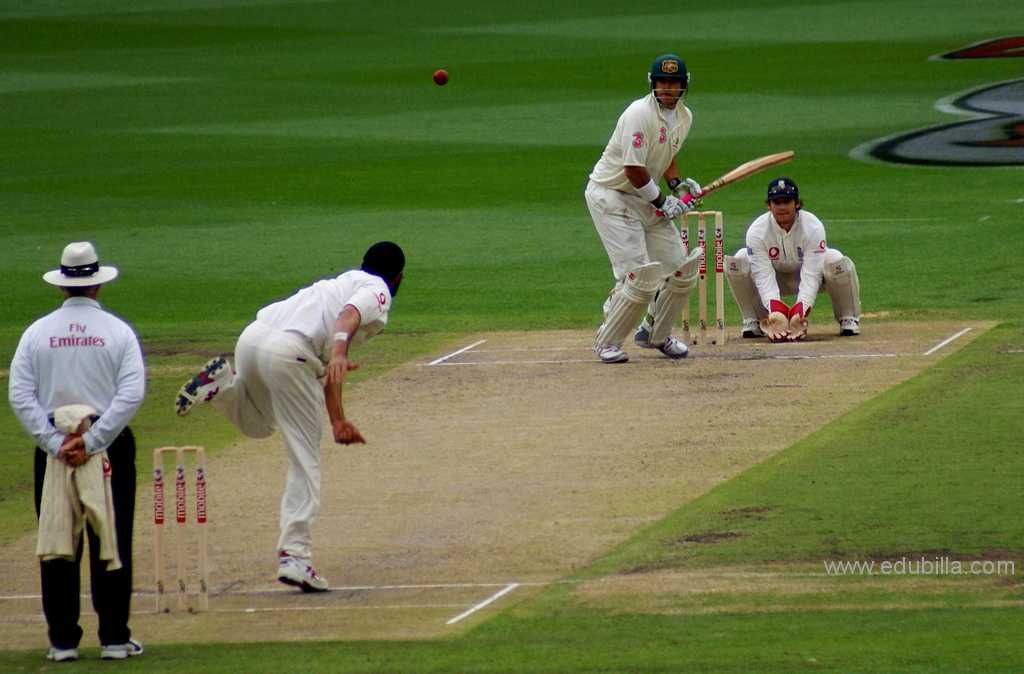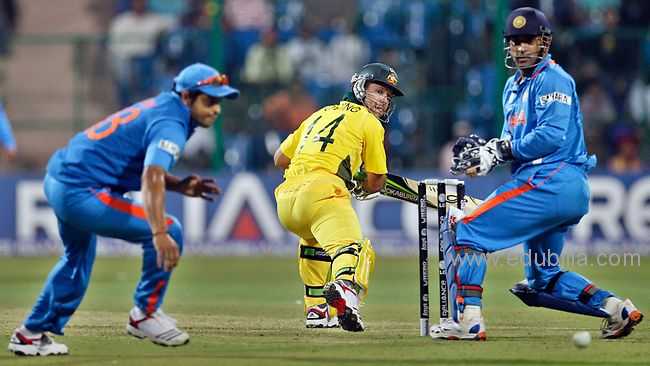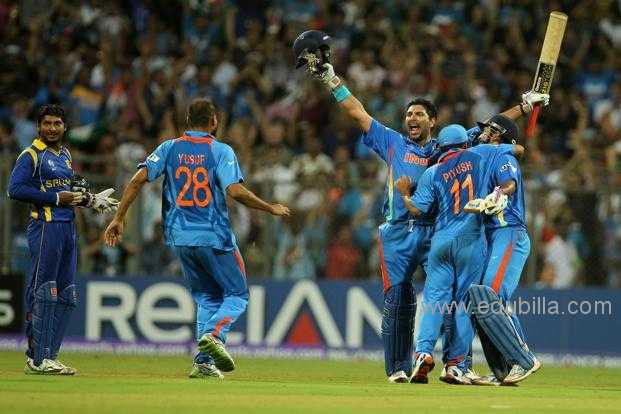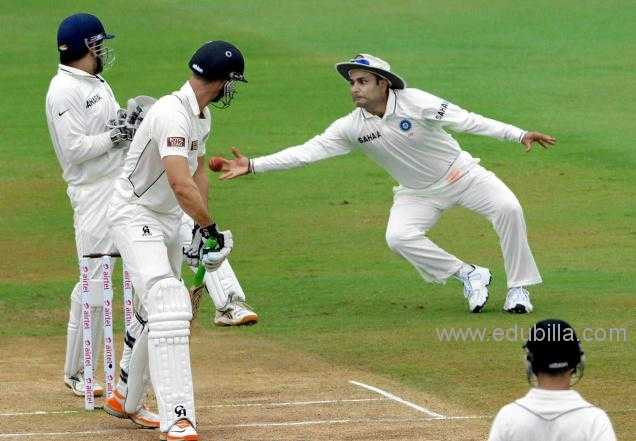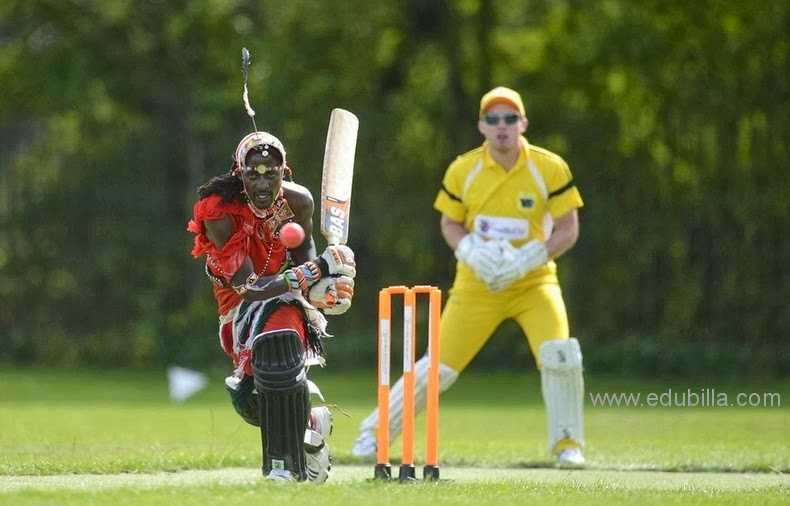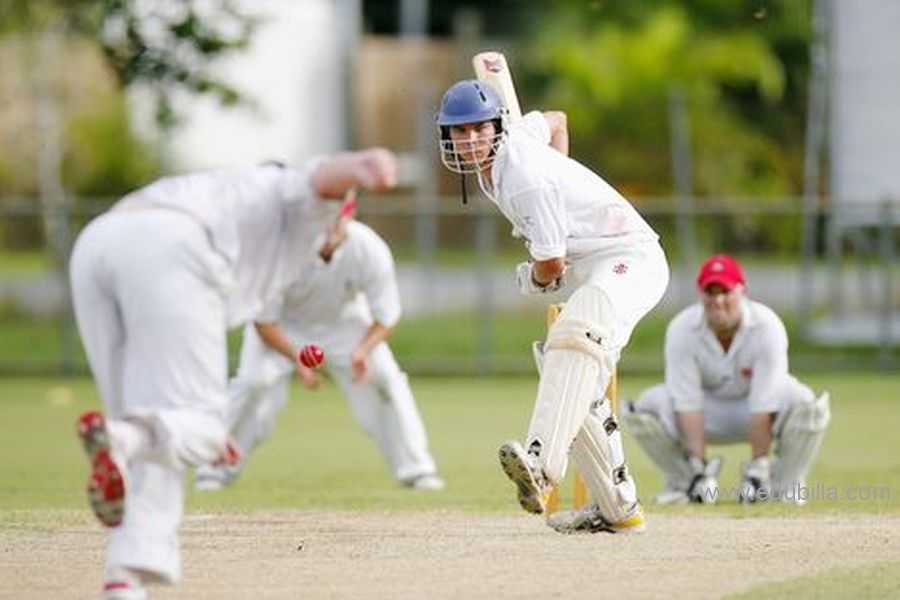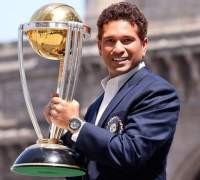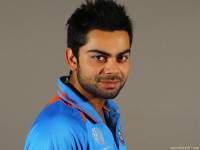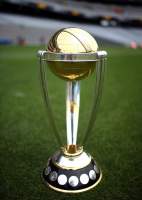
Overview Of Cricket
Cricket is a bat-and-ball game played between two teams of 11 players each on a field at the centre of which is a rectangular 22-yard long pitch. Each team takes its turn to bat, attempting to score runs, while the other team fields. Each turn is known as an innings.
The bowler delivers the ball to the batsman who attempts to hit the ball with his bat away from the fielders so he can run to the other end of the pitch and score a run. Each batsman continues batting until he is out. The batting team continues batting until ten batsmen are out, or a specified number of overs of six balls have been bowled, at which point the teams switch roles and the fielding team comes in to bat.
In professional cricket the length of a game ranges from 20 overs per side to Test cricket played over five days. The Laws of Cricket are maintained by the International Cricket Council (ICC) and the Marylebone Cricket Club (MCC) with additional Standard Playing Conditions for Test matches and One Day Internationals.
Cricket was first played in southern England in the 16th century. By the end of the 18th century, it had developed to be the national sport of England. The expansion of the British Empire led to cricket being played overseas and by the mid-19th century the first international match was held. ICC, the game's governing body, has 10 full members.The game is most popular in Australasia, England, the Indian subcontinent, the West Indies and Southern Africa.
Game Rules
Cricket is a game played between two teams made up of eleven players each. There is also a reserve player called a "twelfth man" who is used should a player be injured during play.The twelfth man is not allowed to bowl, bat, wicket keep or captain the team. His sole duty is to act as a substiture fielder.
The original player is free to return to the game as soon as they have recovered from their injury.To apply the law and make sure the cricket rules are upheld throughout the game there are two umpires in place during games. Umpires are responsible for making decisions and notifying the scorers of these decisions.Two umpires are in place on the playing field while there is also a third umpire off the field who is in charge of video decisions.
Game Structure:
Test cricket is a game that spans over two innings. This means that one team needs to bowl the other team out twice and score more runs then them to win the match. Another key difference between test cricket and other forms of cricket is the length of the innings. In test cricket there is no limit to the innings length. Whereas in one day cricket & Twenty20 cricket there are a certain amount of overs per innings. The only limits in test cricket is a 5 day length. Before the game begins an official will toss a coin. The captain who guesses the correct side of the coin will then choose if they want to bat or field first. One team will then bat while the other will bowl & field. The aim of the batting team is to score runs while the aim of the fielding team is to bowl ten people out and close the batting teams' innings. Although there are eleven people in each team only ten people need to be bowled out as you cannot have one person batting alone. Batting is done in pairs.
Once the first team has been bowled out the second team would then go into bat. Once the second team is then bowled out it would normally return to the first team batting again. However there is an exception to this in the cricket rules, it is called the follow-on. The follow-on is when the first team makes at least 200 runs more than the second team made (in a 5 day test match). This then gives the first team the option to make the second team bat again. This is particularly useful if the game is progressing slowly or affected by bad weather and there might not be enough time for both teams to play a full innings. Should this be the case the batting team's captain also has the right to forfeit their innings at any time. This is called a declaration. Some may wonder why a captain would forfeit the opportunity for his team to bat. However if the game is coming close to a close and it looks like they will not be able to bowl the other team out again this could be an option. If one team is not bowled out twice and a winner determined in the five days of play the game is declared a draw. Therefore it may be worth declaring an innings to creat the possibility of a win rather than a draw.
score runs:
A "No Ball" can be declared for many reasons: If the bowler bowls the ball from the wrong place, the ball is declared dangerous (often happens when bowled at the batsmen's body on the full), bounces more than twice or rolls before reaching the batsman or if fielders are standing in illegal positions. The batsman can hit a no ball and score runs off it but cannot be out from a no ball except if they are ran out, hit the ball twice, handle the ball or obstruct the field. The batsman gains any runs scored off the no ball for his shot while the team also gains one run for the no ball itself.
A "Wide Ball" will be declared if the umpire thinks the batsman did not have a reasonable opportunity to score off the delivery. However if the delivery is bowled over the batsmen's head it will not be declared a wide but a no ball. Umpires are much stricter on wide deliveries in the shorter format of the game while being much more relaxed in test cricket. A wide delivery will add one run to the batting team and any runs scored by the batsman. The batsman is not able to get out off a wide delivery except if they are stumped, run out, handle the ball, hit their wicket or obstruct the field.
A "Bye" is where a ball that isn't a no ball or wide passes the striking batsman and runs are scored without the batsman hitting the ball.
A "Leg Bye" is where runs are scored by hitting the batsman, but not the bat and the ball is not a no ball or wide. However no runs can be scored if the striking batsman didn't attempt to play a shot or if he was avoiding the ball
Ways Batsmen can be given out according to cricket rules:
There are a number of different ways a batsman can be given out in the game of cricket. When a bowler gets a batsman out it is said that the bowler gets a "wicket". Following are the different ways a batsman can be given out according to the rules of cricket:
Bowled - Cricket rules state that if the ball is bowled and hits the striking batsman's wickets the batsman is given out (as long as at least one bail is removed by the ball). It does not matter whether the ball has touched the batsman's bat, gloves, body or any other part of the batsman. However the ball is not allowed to have touched another player or umpire before hitting the wickets.
Caught - Cricket rules state that if a batsman hits the ball or touches the ball at all with his bat or hand/glove holding the bat then the batsman can be caught out. This is done by the fielders, wicket keeper or bowler catching the ball on the full (before it bounces). If this is done then cricket rules state the batsman is out.
Leg Before Wicket (LBW) - If the ball is bowled and it hits the batsman first without the bat hitting it then an LBW decision is possible. However for the umpire to give this out he must first look at some of the factors stated in the cricket rules. The first thing the umpire need to decide is would the ball have hit the wickets if the batsman was not there. If his answer to this is yes and the ball was not pitched on the leg side of the wicket he can safely give the batsman out. However if the ball hits the batsman outside the line of off stump while he was attempting to play a stroke then he is not out.
Stumped - A batsman can be given out according to cricket rules when the wicketkeeper puts down his wicket while he is out of his crease and not attempting a run (if he is attempting a run it would be a runout).
Run Out - Cricket rules state that a batsman is out if no part of his bat or body is grounded behind the popping crease while the ball is in play and the wicket is fairly put down by the fielding side.
Hit Wicket - Cricket rules specify that if a batsman hits his wicket down with his bat or body after the bowler has entered his delivery stried and the ball is in play then he is out. The striking batsman is also out if he hits his wicket down while setting off for his first run.
Handled The Ball - Cricket rules allow the batsman to be given out if he willingly handles the ball with the hand that is not touching the bat without the consent of the opposition.
Timed Out - An incoming batsman must be ready to face a ball or be at the non strikers end with his partner within three minutes of the outgoing batsman being dismissed. If this is not done the incoming batsman can be given out.
Hit The Ball Twice - Cricket rules state that if a batsman hits a ball twice other than for the purpose of protecting his wicket or with consent from the opposition he is out.
Obstructing The Field - A batsman is out if he willingly obstructs the opposition by word or action
Detailed Cricket Rules Can Be Downloaded From Documents
Equipments Need For Cricket
Cricket clothing and equipment:
Cricket clothing and equipment is regulated by the Laws of Cricket. Cricket clothing, known as cricket whites, or flannels, is slightly loose fitting so as not to restrict players' movements. Use of protective equipment, such as helmets, gloves and pads, is also regulated.
Cricket ball:
A cricket ball is a hard, solid ball used to play cricket. A cricket ball consists of cork covered by leather, and manufacture is regulated by cricket law at first class level. The manipulation of a cricket ball, through employment of its various physical properties, is the staple component of bowling and dismissing batsmen – movement in the air, and off the ground, is influenced by the condition of the ball, the efforts of the bowler and the pitch while working on the cricket ball to obtain an optimum condition is a key role of the fielding side. The cricket ball is the principal manner through which the batsman scores runs, by manipulating the ball into a position where it would be safe to take a run, or by directing the ball through the boundary.
Cricket bat:
A cricket bat is a specialised piece of equipment used by batsmen in the sport of cricket to hit the ball, typically consisting of a cane handle attached to a flat-fronted willow-wood blade. The length of the bat may be no more than 38 inches (965 mm) and the width no more than 4.25 inches (108 mm). Its use is first mentioned in 1624.
Cricket Stump:
Stump is a term used in the sport of cricket where it has three meanings, part of the wicket, a manner of dismissing a batsman and the end of the day's play ("stumps").
Each stump is referred to by a specific name:
Off stump is the stump on the off side of the wicket (the same side as the batsman's bat).
Middle (Lie) stump is the centre stump, the middle of the three stumps.
Leg stump is the stump on the on side of the wicket (the same side as the batsman's legs).
Cricket Bail:
In the sport of cricket, a bail is one of the two smaller sticks placed on top of the three stumps to form a wicket. The bails are used to determine when the wicket is broken, which in turn is one of the critical factors in determining whether a batsman is out bowled, stumped, run out or hit wicket.
The wicket is considered to be broken if either one or both of the bails fall from the stumps, or a stump is struck out of the ground, by:
-the ball,
-the striking batsman's bat, or any part of the striker's body or clothing (even if it falls off), or
-a fielder with the hand or arm holding the ball.
cricket Boundary:
In cricket a boundary is the edge or boundary of the playing field, or a scoring shot where the ball is hit to or beyond that point.
The boundary is the edge of the playing field, or the physical object marking the edge of the field, such as a rope or fence. In low-level matches, a series of plastic cones are often used. Since the early 2000s the boundaries at professional matches are often a series of padded cushions carrying sponsors' logos strung along a rope. If it is moved during play (such as by a fielder sliding into the rope) the boundary is considered to remain at the point where that object first stood.
Cricket helmet:
In the sport of cricket, batsmen often wear a helmet to protect themselves from injury or concussion by the cricket ball, which is very hard and can be bowled to them at speeds over 90 miles per hour (140 km/h). Cricket helmets cover the whole of the skull, and have a grill or perspex visor to protect the face. Often constructed with a carbon fibre and Kevlar shell, the helmet is designed to deflect cricket balls as well as shield the wearer from impact, and its liner includes an inflatable element to tightly fit the helmet to its wearer's head
Cricket nets:
A cricket net is a practice net used by batsmen and bowlers to warm up and/or improve their cricketing techniques. Cricket nets consist of a cricket pitch (natural or artificial) which is enclosed by cricket nets on either side, to the rear and optionally the roof. The bowling end of the net is left open. Cricket nets are the cricket equivalent of baseball's batting cages, though fundamentally different, as baseball cages provide complete ball containment, whereas cricket nets do not.
Bowling machine:
In cricket a bowling machine is a device which enables a batsman to practice (usually in the nets) and to hone specific skills through repetition of the ball being bowled at a certain length, line and speed. It can also be used when there is no-one available to bowl, or no one of the desired style or standard.
There are a number of different types of bowling machine available to cricket coaches, each quite different in the ways they achieve the required delivery, though most allow the use of remote control, so that a coach can be closer to a batsman when the stroke is played.
Cricket Pads:
Pads (also called leg guards) are protective equipment used by batters in the sports of cricket and baseball, and by goaltenders in hockey, bandy and lacrosse. They serve to protect the legs from impact by a hard ball or puck at high speed which could otherwise cause injuries to the lower leg.
Ball gauge:
A ball gauge is an instrument used by the umpires in cricket to check whether the size of a cricket ball meets the standard measurements mandated by the Laws of Cricket. It is usually in a form somewhat like a pair of handcuffs with two connected rings: one ring has the minimum acceptable diameter, through which the ball should not pass; the other ring has the maximum acceptable diameter, through which the ball should pass.
If the ball cannot pass through the maximum diameter, or passes through the minimum diameter, or becomes mis-shapen, the umpires should replace the ball. The replacement ball is ideally an old ball that was used in a previous match for a comparable number of overs as the ball being replaced, so that it has had approximately the same amount of use and wear as the old ball.
Batting glove:
Batting gloves are a component in baseball sportswear. Typically consisting of a leather palm and back made of nylon or another synthetic fabric, the glove covers one or both hands of a batter, providing comfort, prevention of blisters, warmth, improved grip, and shock absorption when hitting the ball. The use of gloves is not obligatory in any level of the game, but they are considered an essential part of baseball clothing and equipment.
History Of Cricket
The game of cricket has a known history spanning from the 16th century to the present day, with international matches played since 1844, although the official history of international Test cricket began in 1877. During this time, the game developed from its origins in England into a game which is now played professionally in most of the Commonwealth of Nations.
Derivation of the name of "cricket":
A number of words are thought to be possible sources for the term "cricket". In the earliest known reference to the sport in 1598 (see below), it is called creckett. The name may have been derived from the Middle Dutch krick(-e), meaning a stick; or the Old English cricc or cryce meaning a crutch or staff.Another possible source is the Middle Dutch word krickstoel, meaning a long low stool used for kneeling in church and which resembled the long low wicket with two stumps used in early cricket.
First definite reference:
Despite many prior suggested references, the first definite mention of the game is found in a 1598 court case concerning an ownership dispute over a plot of common land in Guildford, Surrey. A 59-year old coroner, John Derrick, testified that he and his school friends had played creckett on the site fifty years earlier when they attended the Free School. Derrick's account proves beyond reasonable doubt that the game was being played in Surrey circa 1550.There is insufficient evidence that a "1533 poem, attributed to John Skelton"(who died in 1529) is the earliest known reference to the sport.
Early 17th century:
A number of references occur up to the English Civil War and these indicate that cricket had become an adult game contested by parish teams, but there is no evidence of county strength teams at this time. Equally, there is little evidence of the rampant gambling that characterised the game throughout the 18th century.
International cricket begins:
The first ever international cricket game was between the USA and Canada in 1844. The match was played at the grounds of the St George's Cricket Club in New York.
In 1859, a team of leading English professionals set off to North America on the first-ever overseas tour and, in 1862, the first English team toured Australia.
Between May and October 1868, a team of Australian Aborigines toured England in what was the first Australian cricket team to travel overseas.
The first Australian touring team (1878) pictured at Niagara Falls:
In 1877, an England touring team in Australia played two matches against full Australian XIs that are now regarded as the inaugural Test matches. The following year, the Australians toured England for the first time and were a spectacular success. No Tests were played on that tour but more soon followed and, at The Oval in 1882, arguably the most famous match of all time gave rise to The Ashes. South Africa became the third Test nation in 1889.
cricket in India:
The entire history of cricket in India and the sub-continent as a whole is based on the existence and development of the British Raj via the East India Company.
On 31 December 1600, Queen Elizabeth I granted a Royal Charter to the East India Company, often colloquially referred to as "John Company". It was initially a joint-stock company that sought trading privileges in India and the East Indies, but the Royal Charter effectively gave it a 21 year monopoly on all trade in the region. In time, the East India Company transformed from a commercial trading venture to one which virtually ruled India as it acquired auxiliary governmental and military functions, until its dissolution in 1858 following the Indian Mutiny. The East India Company was the means by which cricket was introduced into India.
In 1639, the Company effectively founded the city of Madras, and in 1661 acquired Portuguese territory on the west coast of India that included Bombay. In 1690, an Anglo-Moghul treaty allowed English merchants to establish a trading settlement on the Hooghly River, which became Calcutta. All of these places became major cricket centres as the popularity of the game grew among the native population.
Indian Cricket Team:
The Indian cricket team made its Test cricket debut in 1932 and has since advanced to be among the top four test teams in the ICC rankings in each of 2005 to 2008.The team won the Cricket World Cup in 1983 and 2011
Origin Of Cricket
No one knows when or where cricket began but there is a body of evidence, much of it circumstantial, that strongly suggests the game was devised during Saxon or Norman times by children living in the Weald, an area of dense woodlands and clearings in south-east England that lies across Kent and Sussex. It is generally believed that cricket survived as a children's game for many generations before it was increasingly taken up by adults around the beginning of the 17th century. Possibly cricket was derived from bowls, assuming bowls is the older sport, by the intervention of a batsman trying to stop the ball from reaching its target by hitting it away. Playing on sheep-grazed land or in clearings, the original implements may have been a matted lump of sheep’s wool (or even a stone or a small lump of wood) as the ball; a stick or a crook or another farm tool as the bat; and a stool or a tree stump or a gate (e.g., a wicket gate) as the wicket.
First Cricket Game:
Evidence suggests it was played in England in the 12th–13th cent., and it was popular there by the end of the 17th cent. By the mid-18th cent. the aristocracy had adopted the game. In 1744 the London Cricket Club produced what are recognizably the rules of modern cricket. The Marylebone Cricket Club, one of the oldest (1787) cricket organizations, is the game's international governing body.
First Indoor Cricket:
Indoor Cricket was first invented in 1970.It is similar to outdoor cricket except that is played in an indoor sports hall with 6 players per team. It is extremely popular in the UK with national championships and multiple independent leagues. Another less formal version of indoor cricket is played in a smaller arena with a soft ball and without pads was invented some years later and is commonly played in the Southern Hemisphere, and even has its own nominal international championships, including World Cups.
First Cricket players:
Cricket was first played in southern England in the 16th century. By the end of the 18th century, it had developed to be the national sport of England. The expansion of the British Empire led to cricket being played overseas and by the mid-19th century the first international match was held. ICC, the game's governing body, has 10 full members.The game is most popular in Australasia, England, the Indian subcontinent, the West Indies and Southern Africa.
Governing Bodies
International Cricket Council (ICC):
The International Cricket Council (ICC) is the international governing body of cricket. It was founded as the Imperial Cricket Conference in 1909 by representatives from England, Australia and South Africa, renamed the International Cricket Conference in 1965, and took up its current name in 1989.
The ICC has 106 members: 10 Full Members that play-official Test matches, 37 Associate Members,and 59 Affiliate Members.The ICC is responsible for the organisation and governance of cricket's major international tournaments, most notably the Cricket World Cup. It also appoints the umpires and referees that officiate at all sanctioned Test matches, One Day International and Twenty20 Internationals. It promulgates the ICC Code of Conduct, which sets professional standards of discipline for international cricket,and also co-ordinates action against corruption and match-fixing through its Anti-Corruption and Security Unit (ACSU). The ICC does not control bilateral fixtures between member countries (which include all Test matches), it does not govern domestic cricket in member countries, and it does not make the laws of the game, which remain under the control of the Marylebone Cricket Club.
The First Cricket World Cup:
The first ever international cricket match was played between Canada and the United States, on the 24 and 25 September 1844.However, the first credited Test match was played in 1877 between Australia and England, and the two teams competed regularly for The Ashes in subsequent years. South Africa was admitted to Test status in 1889.Representative cricket teams were selected to tour each other, resulting in bilateral competition. Cricket was also included as an Olympic sport at the 1900 Paris Games, where Great Britain defeated France to win the gold medal.This was the only appearance of cricket at the Summer Olympics.
The First Cricket Cup in India:
The first cricket club in India was established in Calcutta in 1792, India's national cricket team did not play its first Test match until 25 June 1932 at Lord's.They became the sixth team to be granted Test cricket status.In its first fifty years of international cricket, India was one of the weaker teams in international cricket, winning only 35 of the 196 Test matches it played during the period.The team, however, gained strength in the 1970s with the emergence of players such as batsmen Sunil Gavaskar and Gundappa Vishwanath, all-rounder Kapil Dev and the Indian spin quartet – Erapalli Prasanna and Srinivas Venkataraghavan (both off spinners), Bhagwat Chandrasekhar (a leg spinner), and Bishen Singh Bedi (a left-arm spinner). Traditionally much stronger at home than abroad, the Indian team has improved its overseas form since the start of the 21st century, winning Test matches in Australia, England and South Africa. It has won the Cricket World Cup twice – in 1983 under the captaincy of Kapil Dev and in 2011 under Mahendra Singh Dhoni's captaincy. After winning the 2011 World Cup, India became only the third team after West Indies and Australia to have won the World Cup more than once,and the first cricket team to win the World Cup at home. It has won the 2007 ICC World Twenty20 and 2013 ICC Champions Trophy, under the captaincy of Dhoni. It was also the joint champions of 2002 ICC ChampionsTrophy, along with Sri Lanka.
Awards Related To Cricket
ICC Awards:
The ICC Awards is a set of sports awards for cricket. The awards recognise and honour the best international cricket players of the previous 12 months. The Awards has been institutionalised by International Cricket Council since 2004.
Award categories:
ICC Player of the Year(Sir Garfield Sobers Trophy):
The Sir Garfield Sobers Trophy is a cricket trophy awarded annually by the International Cricket Council to its chosen world player of the Year. It was first awarded in 2004 to Rahul Dravid.
The trophy is handcrafted by leading international crystal manufacturer Swarovski. The design features a red crystal cricket ball studded with over 4200 Swarovski crystal chantons, resting on a brass hand extended from a gold-plated base.
ICC Women's Cricketer of the Year:
The International Cricket Council (ICC) Women's Cricketer of the Year is an award given annually as part of the ICC Awards ceremony.Although the Awards were first held in 2004,the first women's award was made in 2006. Karen Rolton, the inaugural winner of the award commented that it was "great for women's cricket... that the ICC has included a women's award this year"
ICC One-day Player of the Year Award:
The ICC One-day Player of the Year is an annual award presented since 2004 by the International Cricket Council to the best One Day International player.
The trophy is handcrafted by leading international crystal manufacturer Swarovski. The design features a red crystal cricket ball studded with over 4200 Swarovski crystal chantons, resting on a brass hand extended from a gold-plated base.
T20 Player of the Year
Captain of the Year
Emerging Player of the Year:
Players eligible for this award must be under 26 years of age at the start of the voting period and have played no more than five Tests and/or 10 ODIs before that date.
ICC Test Team of the Year:
The ICC Test Team of the Year is an honor awarded each year by the International Cricket Council. It recognizes the top players from around the world. The team does not actually compete, but exists solely as an honorary entity.
Spirit of Cricket Award:
Described by the ICC as awarded to the team most notable for "upholding the 'Spirit of the Game', involving respect for:
-Their opponents
-Their own captain and team
-The role of the umpires
-The game's traditional values"
The Asian Awards:
The Asian Awards is an award ceremony which takes place in the United Kingdom that recognises and rewards exemplary achievement across 14 categories that include business, philanthropy, entertainment, culture and sport. Nominees are selected by an independent judging panel consisting a panel co-chaired by Baroness Verma of Leicester and Nat Wei, Baron Wei.The Asian Awards, reward outstanding achievement from within the Asian community. In 2010 and 2011, the awards were only open to those born in or with direct family origin from India, Sri Lanka, Pakistan, or Bangladesh. In 2013, the Asian Awards were opened to all people of both South and Eastern Asian origin. This pan-Asian expansion continued through to the 4th Asian Awards.The 5th Asian Awards will take place on 17 April 2015 in London.
Sample Documents Of Cricket
-Pele

